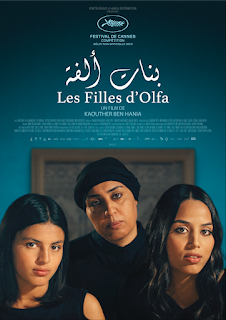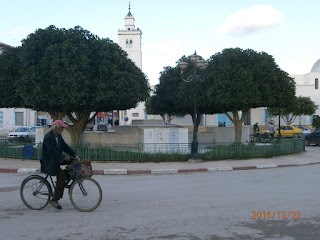Olfa’s Daughters by Kawther ben Hneya (2023)
Reviewing the Tunisian Film Olfa's Daughters
Written by Amira Masrour
Edited by Micheal Dickens
Olfa's Daughters has been premiered in the competition at Cannes Film Festival in 2023. Directed by Kawther ben Hneya, a Tunisian director of an already reviewed film called The Man Who Sold his Back.
Trailer of the film

Characters and their analysis:
We can notice that the presence of characters in the film is very minimalist.
Olfa: the protagonist is portrayed by both Olfa Hamrouni and Hend Sabri. The real Olfa has played multiple roles. She has worked as an actress, film director and the screenwriter.
Unlike the other films, this one is atypical as its protagonist is its screenwriter. She also plays the role of director when directing the actors about what happened.
Ghofrane: the eldest daughter, she was born in 1998. She is starred by Ishrak Matar. In 2013, she wore the niqab. Throughout the film, she is portrayed by her sisters and Olfa as being haunted by the demon.
Rahma: was born in 1999. She is the most fundamentalist and “puritanical” in her sisters. She used to flag her three sisters when they commit any mistake believing that when doing so they will purify their bodies from the sins. Moreover, she is the one who created the game of death that they used to enjoy playing together.
Eya: was born in 2003. Eya and her sister Taysir were the only ones to be present in filming while the two others were not.
Taysir: the youngest, she was born in 2005.
The Three Male Characters were portrayed by the same actor Majd Mastoura. Abderhman, Olfa’s first husband, Wissem, the second husband or her boyfriend and the policeman.
Themes:
Patriarchy:
Patriarchy is omnipresent in the film. Even olfa, the first victim of such phenomenon, is also enforcing certain misogynistic, patriarchal social policies in raising her daughters by not allowing them to meet young men or even removing their unwanted hair. The film sheds the light on the man’s power in the Tunisian society. Even though it is apparent that women do have their legal rights and are equally treated as men, there are still many silent social codes which are governing the Tunisian mentality. We can mention the case of virginity which is represented in the scene when Olfa is forced by her husband during the first night together to show the sign of her virginity.
The Body:
The female body is represented in the film as a source of shame which should be covered. It is man’s property. “ your body doesn’t belong to you. It is men’s. That’s why, you should protect it till the marriage..” this what Olfa said to her daughter.
Such belief is clearly illustrated in the scene of Olfa’s first night with her husband. In this scene, Abderahmen, her husband has tried to force her to sleep with him. Even her sister advises her husband to block Olfa in the corner for deflowering. On the other hand, she completely refuses that and prevents him from doing so. She even fights him till he bleeds. What is funny here is that she uses that blood to show it to her family pretending it is her virginity’s blood.
Exorcism in Islam:
In relation to what has been said above, the demonic possession is a form of body denial. She tends to deny and disconnect with her body as being an entity that has been defiled by past experiences. As if she is devoting her body to another entity, the djin, in order to purify her soul from past impurities.
Dissociation1 :
According to an academic study, possession by demon is a manifestation of a dissociative identity disorder (DID) which is the case with Ghofrane which in several scenes has been shown ill and unable to control her body. In other words, this phenomenon of dissociation is a mental illness that represents “a mechanism of defense” in the face of a past trauma that happened during the childhood (Volkan,8). In this case, the child is deprived of feelings of safety and family love which pushes him to resort to this form of dissociation as a way to escape past trauma. In fact, this is exactly what happened with Ghofrane who resorts to dissociation to flee all sorts of violence and abusive situations she has witnessed throughout her childhood such as the absence of her father, her mother’s physical and verbal violence and so on.
Religion: a Curse or Blessing?
Religion is very visible in this movie throughout characters’ clothes and behaviours. The eldest daughters put on the niquab as a way to embrace Islam and to renew their relationship with god. Being near to Allah, did it enhance their life or the opposite? If not why? What’s wrong? It is expected that religion purifies the soul of people. Yet, it is not the case with the girls in the movie. It, on the contrary, turns their life upside down. They, even, get imprisoned. Is it because of religion itself or another entity?
Religion is represented in the film by Salafism which is a radical Islamic ideology perpetuated by the Islamic State of Iraq and Syria (ISIS). Such ideology was widespread in Tunisia after 2011 revolution and influenced many Tunisians especially those who have psychological deficiency. The eldest girls are among those who are captured by this ideology. Sheiks in their neighbourhood convince them that they should change their life style in order to improve their life. Such change can be done only by adopting a radicalized life style like wearing the niquab, doing the Salat (prayer) and even applying some Islamic rules like stoning the adulterer or flogging the sinner.
Slang Words in Communication2:
Language is a dynamic entity shaped by culture and context in which humans communicate. It has many aspects including slang which is form of informal way of communication used among specific group of people. It functions as a social differentiation. People tend to use slang words that are not used in formal discussions to express their attitudes, feelings and mood. It is also a sign of revolution and confidence. Those words are used to express anger and repression as formal language fails to do so. If we shed the light on the evolution of slang words in Tunisia, we will notice that they used to be employed by delinquent, criminal and marginalized people. Throughout time, it becomes predominant among teenagers due to media and digital life. In early Tunisia, these kind of words used to be employed outdoor and by man mainly. Step by step, it becomes predominant among female lexicon. Such behaviour is very obvious in our movie among the female characters. The film focuses on the social background and the psychological state of Olfa and her daughters who belong to marginalized people.
Are we going to blame the movie, as it is part of media, for its emission of slang words? Is it responsible for the bad influence of teenagers who are going to watch it?
Techniques:
Oscillation between Drama and Reporting:
Story telling: unlike other documentaries in which story tellers’ role consists of just helping the producer in recollecting memories and actions. This one involves story tellers in acting as they turn into real actors. This technique reconstructs the past. It has a therapeutic effect on the actors of the film as it gives the opportunity to live again lost moments. By reliving them, they will be able to develop themselves and see situations from another perspective with more maturity.
The Impact of the Film:
Catharsis is omnipresent in the film. From the beginning of the scenes, I didn’t prevent myself from crying. This is what makes this film a therapy to its audience.
The film gives Olfa and her daughters an opportunity to comfort trauma through reenactment. The characters sort out their emotions in many scenes that reflect upon abuse and oppression.
References:
1Volkan, K. (2023). The Jinn: Islam, Exorcism, and Psychology. Journal of Social and Political Sciences, 6(3), 1-14.
2Sourour, Jebali. The use of slang language among Tunisian youth. Academia.
https://www.academia.edu/29268486/The_use_of_slang_language_among_Tunisian_youth



Comments
Post a Comment